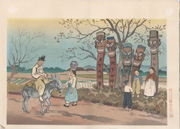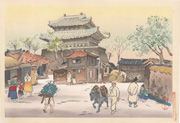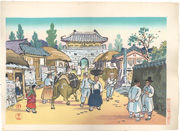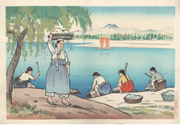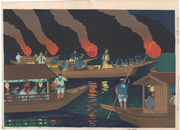Prints in Collection
Sheltering from the Rain,
c. 1950/1960
IHL Cat. #2312
Totems from the series Korean Life,
c. 1952-1960
IHL Cat. #1360
Castle Gate from the series Korean Life,
c. 1952-1960
IHL Cat. #1361
Source: Guide to Modern Japanese Woodblock Prints: 1900-1975, Helen Merritt, University of Hawaii Press, 1992, p. 37 and 3 “Artistic Trends in Korean Painting,” Youngna Kim appearing in War, Occupation, and Creativity: Japan and East Asia, 1920-1960, edited by Marlene J. Mayo, J. Thomas Rimer, H. Eleanor Kerkham, University of Hawai'i Press, 2001, p. 124.
In the early 1950s he began designing woodblock prints for the publisher Kyoto Hangain. Most of these works consist of scenes of Korean customs and scenic places, idyllic remembrances of Mamoru's many years living there. Typically, they are signed M. Hiyoshi with a stylized seal of Mamoru [守], as shown below.

Mamoru seal of the artist
1 Artist's name in Korean 히요시 마모루
2 Encyclopedia of Korean Culture http://encykorea.aks.ac.kr/Contents/Index?contents_id=E0071751 [last accessed 6/23/2020]
3 Hiyoshi Mamoru, “Chosen bijutsukai no kaiko”(Recollections of the Art World in Korea)

